This post may contain affiliate links. Please read our disclosure policy.
How to make Lebanese markouk saj bread at home with just 6 ingredients and an inverted wok/kadai or pancake pan. This thin Middle Eastern flatbread is fairly simple to prepare and perfect for making in large batches to serve with any meal of the day!
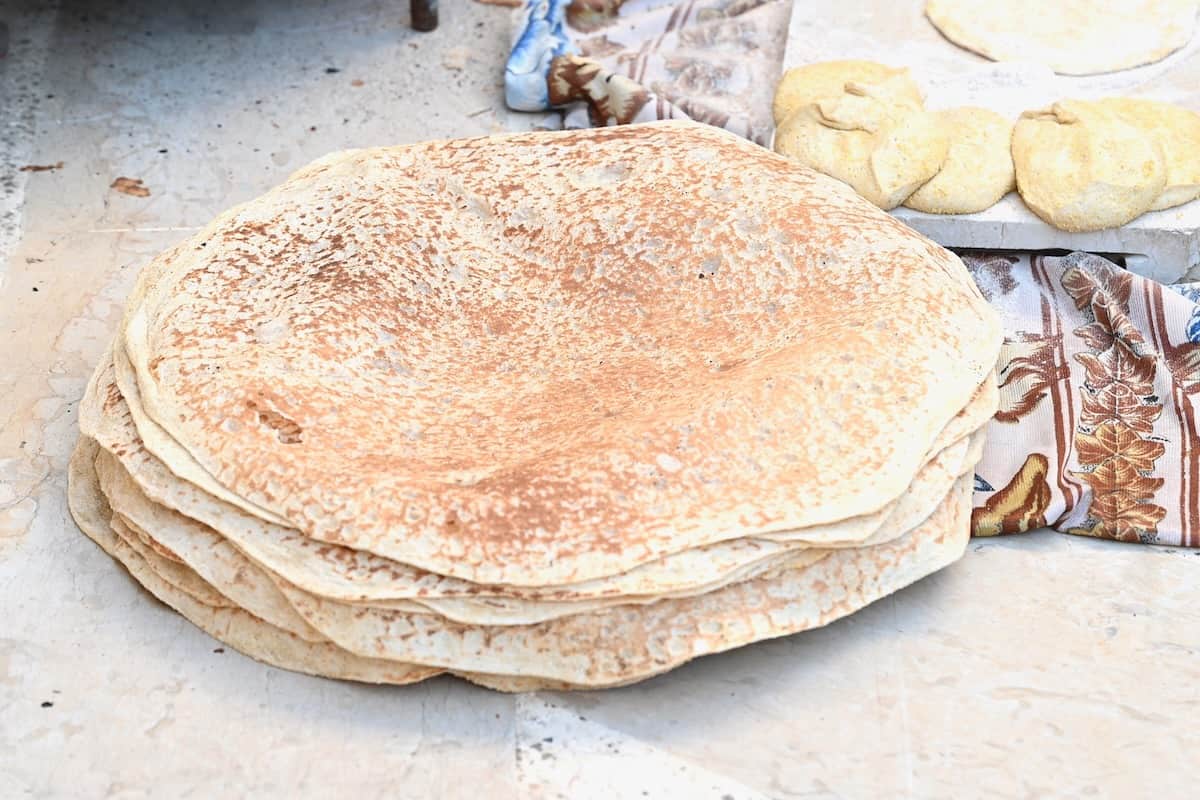
While I’ve already shared several flatbread recipes from my Lebanese roots, including authentic pita bread and manakish bread, during my latest trip to Lebanon, my mother took me through her “Lebanese mother-approved” method of making markouk saj bread. This Lebanese flatbread is super thin, slightly crispy, and perfect for enjoying with mezze, breakfast, stews, and being turned into wraps!
Want to save this recipe?
What is Markouk/Saj bread?
With this bread that comes under so many names, I feel like several things need explaining. So, first of all, what is saj bread?
It is a popular Middle Eastern and South Asian unleavened flatbread cooked on a convex metal griddle, called a Saj (or Tava). When referring to saj bread, it’s more like a “category” of bread rather than the recipe itself. There are several options, including Indian Tava roti, Turkish Yufka bread or Gözleme, and Palestinian Shrāke bread – which is very similar to markouk/markook which is what we’re making here.
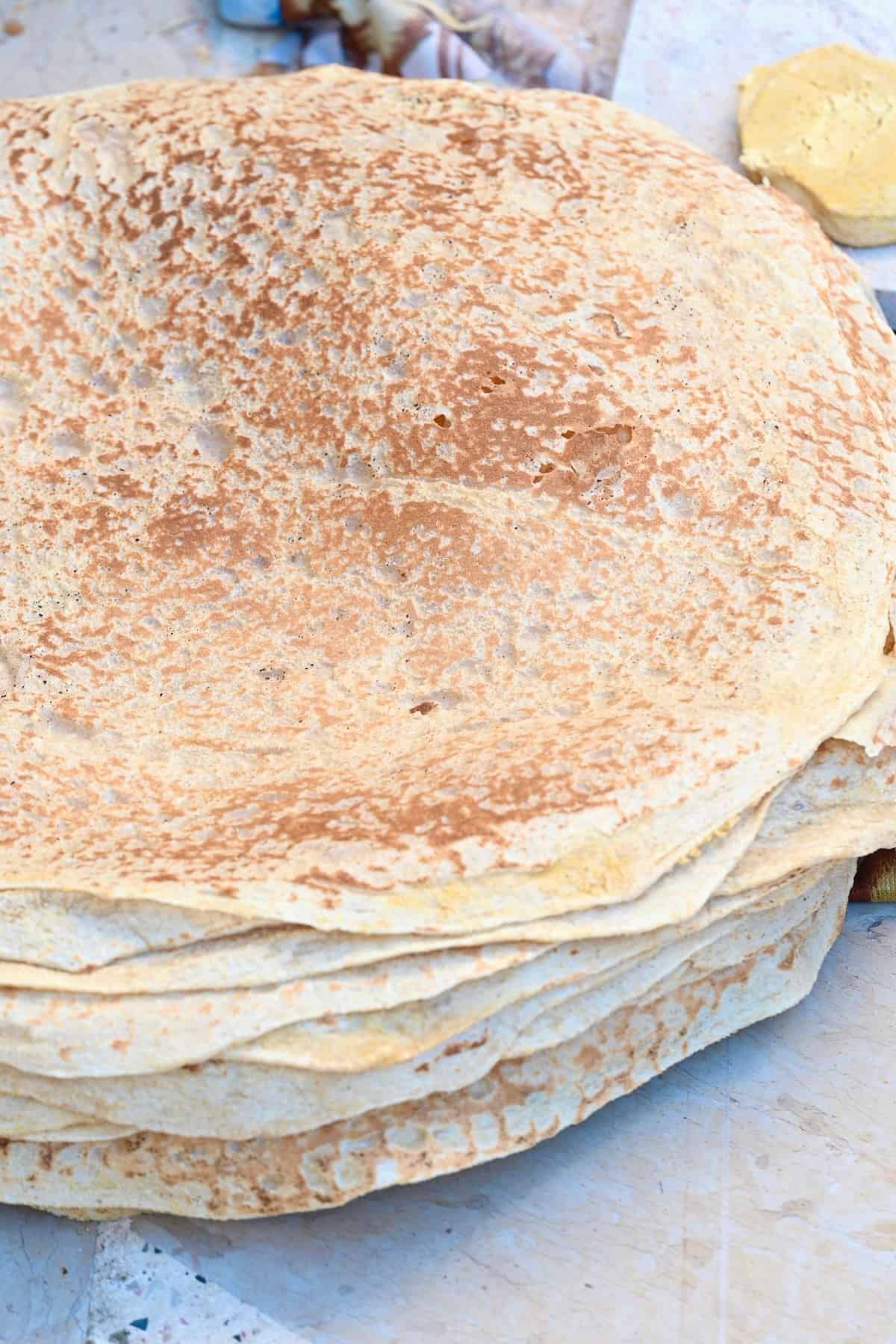
Markouk bread is the king of Middle Eastern unleavened flatbreads (though often uses yeast in homemade versions – as I’ve done) and comes under several names: markook, shrak, mashrooh, khubz ruqaq, and more.
In this post, I will show you how to make saj bread – traditionally it uses the concave round metal pan but it’s easy to recreate a home with household items.
With just a few simple ingredients, markouk bread is incredibly simple to prepare into a dough. However, the most interesting “feature” of this version is how paper-thin it is. To achieve this, the dough is stretched over a soft cushion before being flipped onto the saj to cook. You can use an inverted wok/kadai or even a pancake pan for this homemade flatbread recipe.
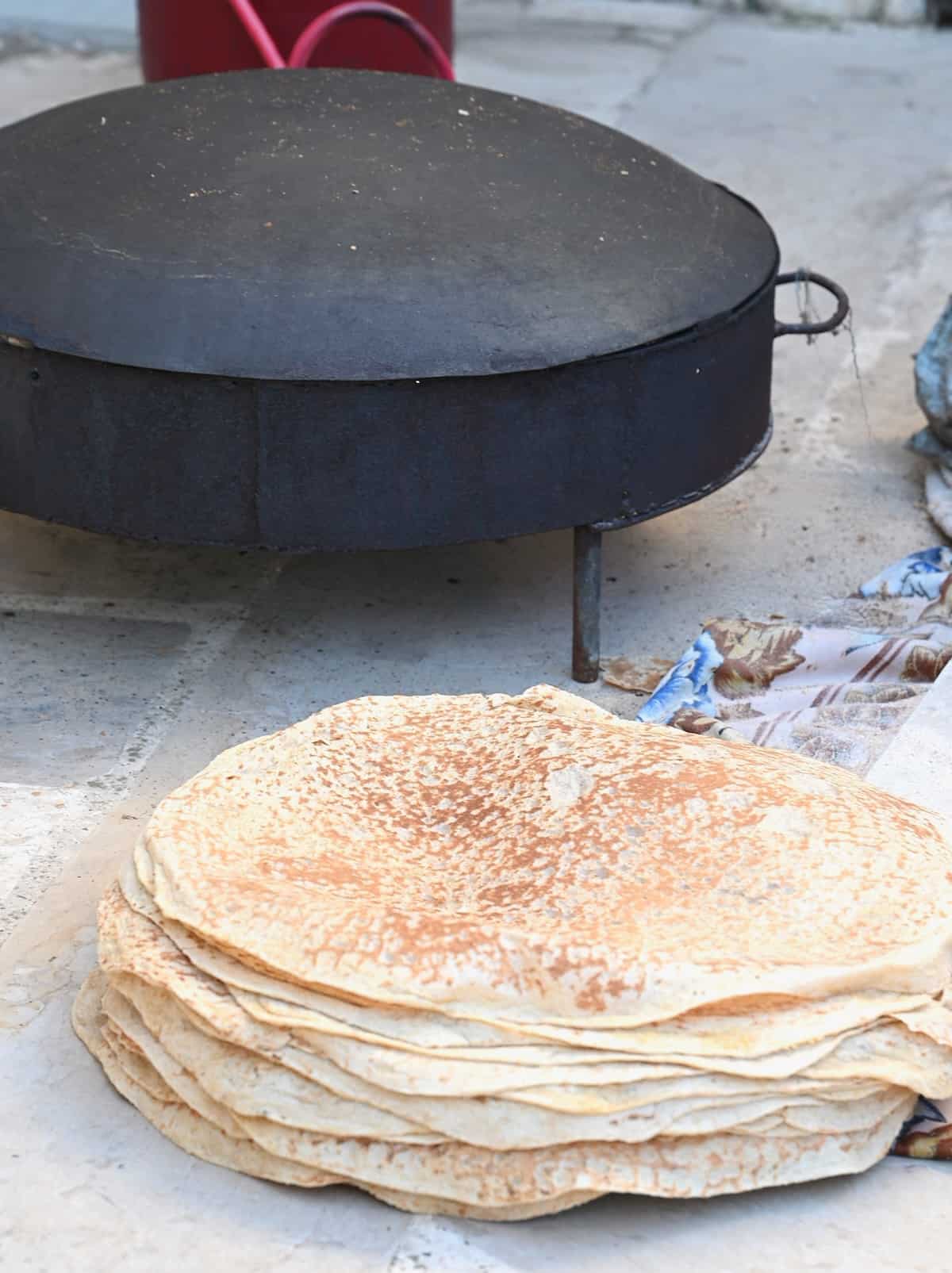
The Lebanese Flatbread Ingredients
- Flour: I used a combination of regular all-purpose white flour and whole-wheat flour for bread that is flavorful but still soft and flexible.
- Salt: Needed to add flavor to the dough.
- Yeast & Sugar: The sugar will help to “feed” and activate the yeast. While many versions are unleavened, this recipe was passed down from my mother – who has always used yeast.
- Water: You’ll need water to create the dough and more to help shape and stretch the dough.
- Cornmeal: This is used for dusting the dough to prevent sticking. While I used cornmeal, any flour would work.
What Else You’ll Need
- Round pillow: For most households, this pillow is used exclusively for food purposes and is washed often. However, you could cover a round cushion with a clean cloth/kitchen towel if you don’t have a dedicated one.
- Cooking Tool: A Saj is a large convex griddle tool, so the closest household alternative is to use an inverted wok/Kadai with a smooth rounded bottom. Alternatively, you can use a large, flat crepe pan.
Chef’s Tip: It’s best if the cushion and pan are similar sizes (or if the pillow is slightly smaller). That way, once you’ve stretched the dough across the cushion, it will easily transfer to the pan. Traditionally, this Arabic flatbread is 24in/60cm but adjust this to the tools you have available.
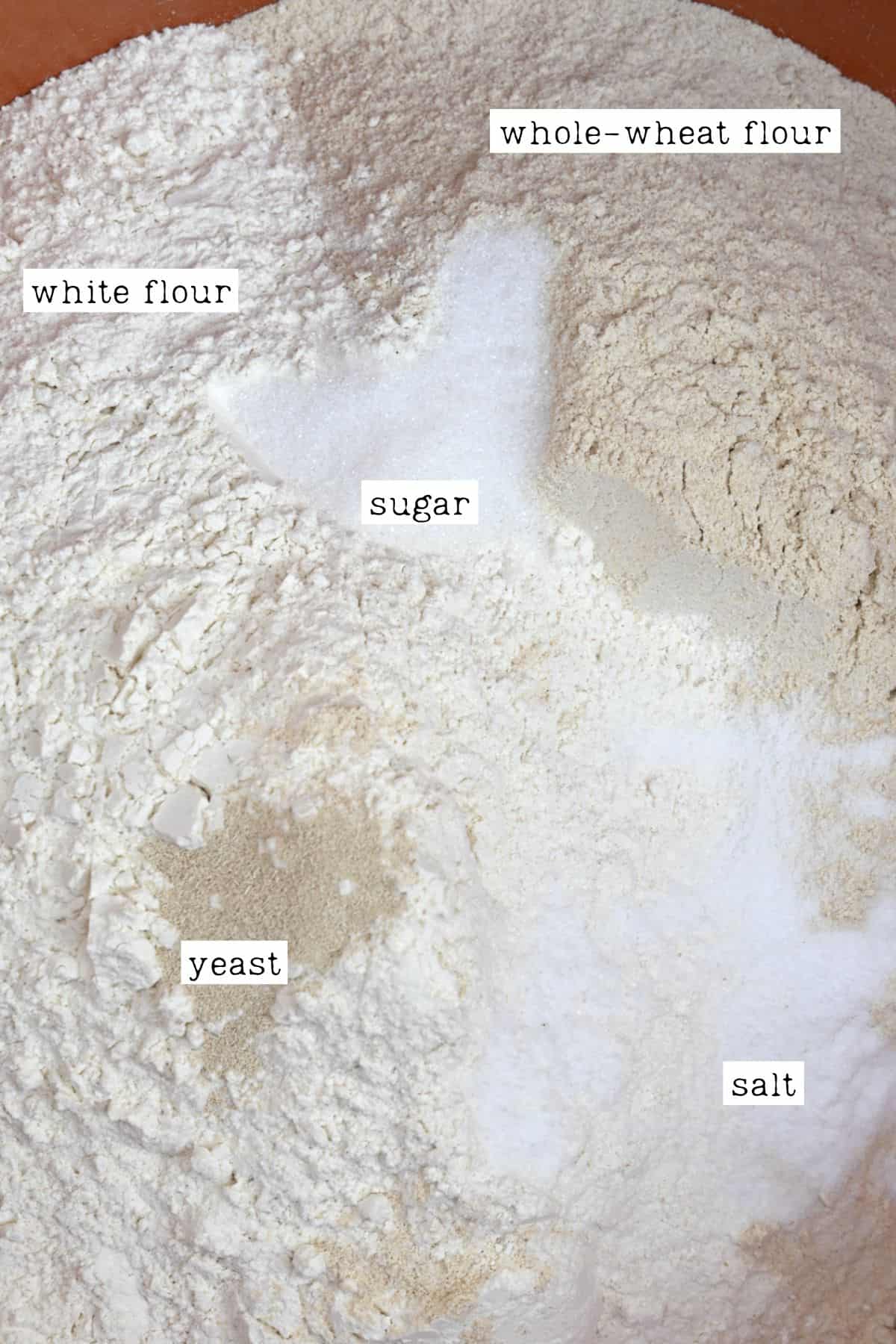
How to Make Lebanese Markouk Saj Bread?
While there are several steps to preparing this markook bread, the actual process is fairly simple. The trickiest part will be stretching the dough – but with a bit of practice, you’ll pick it up in no time!
Step 1: Prepare the Dough
First, sift both types of flour into a large bowl. Then add the salt, sugar, and yeast and whisk well to combine.
Then, add the cold water gradually, incorporating it into the dry ingredients until a soft dough has formed.
Knead the dough mixture for between 6-10 minutes until you have a smooth, elastic dough. You could also try these steps using a mixer, though I haven’t before, and the time it takes to achieve the smooth, elastic dough will differ.
Step 2: Divide and Rest the Dough
Divide the dough into (around) 40 even pieces. For perfectly even pieces, weigh each one out. If you aren’t too bothered about uniformity, you can do this by eye.
Note – if your wok/Kadai cooking tool is much smaller than the one I used (24 in/60 cm), then you can adjust the size of each dough ball accordingly.
Dip your hands in water before shaping each dough piece into a ball – folding the edges underneath and pinching them together. Then roll/sprinkle each ball with cornmeal and place them into a large flour-dusted bowl. Once all the dough balls are in the bowl, cover it with a clean, damp cloth/kitchen towel and leave it to rest for at least five hours – or overnight.
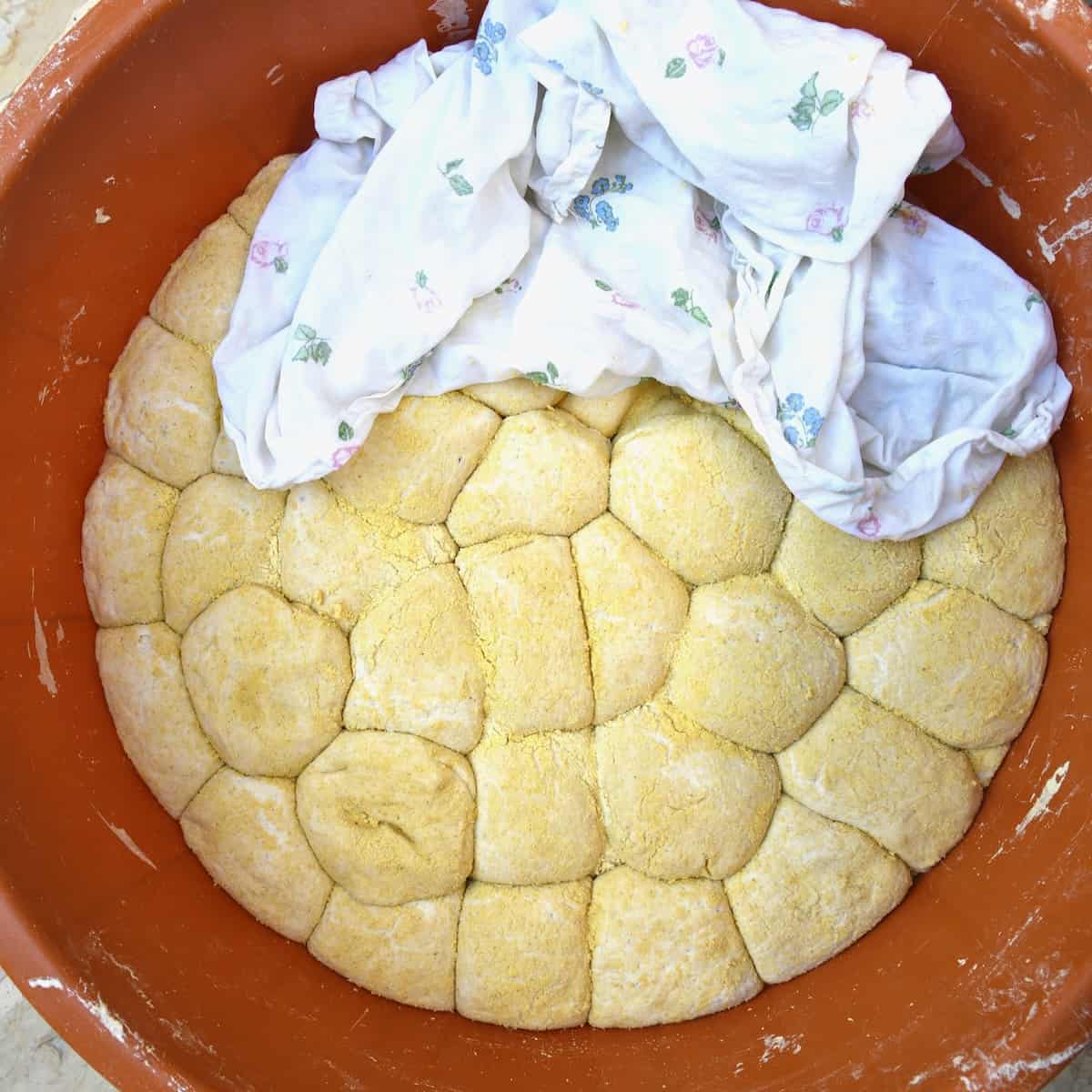
Step 3: Shape the Lebanese Flatbread
Dust your working surface with some whole wheat flour. Then, working with one ball of dough at a time, punch it down onto the surface to release extra air.
Using your fingers, press the dough down on the edges (not the middle), rotating it often to stretch it into a large circular shape (similar to shaping pizza dough). Sprinkle the dough with flour often so it doesn’t stick.
Once it is as thin as you can get it with just your fingers dimpling the dough, it’s time to use your whole hands to stretch it further. This bit is tricky to explain – but actually relatively simple to do. Place the dough in your left hand (you can do it from the palm or the top (whichever feels easiest for you) and then twist it quickly to transfer it to the palm of your right hand and back and forth and back and forth. (like this) or if you want, get fancy with it like many Lebanese mothers/grandmothers.
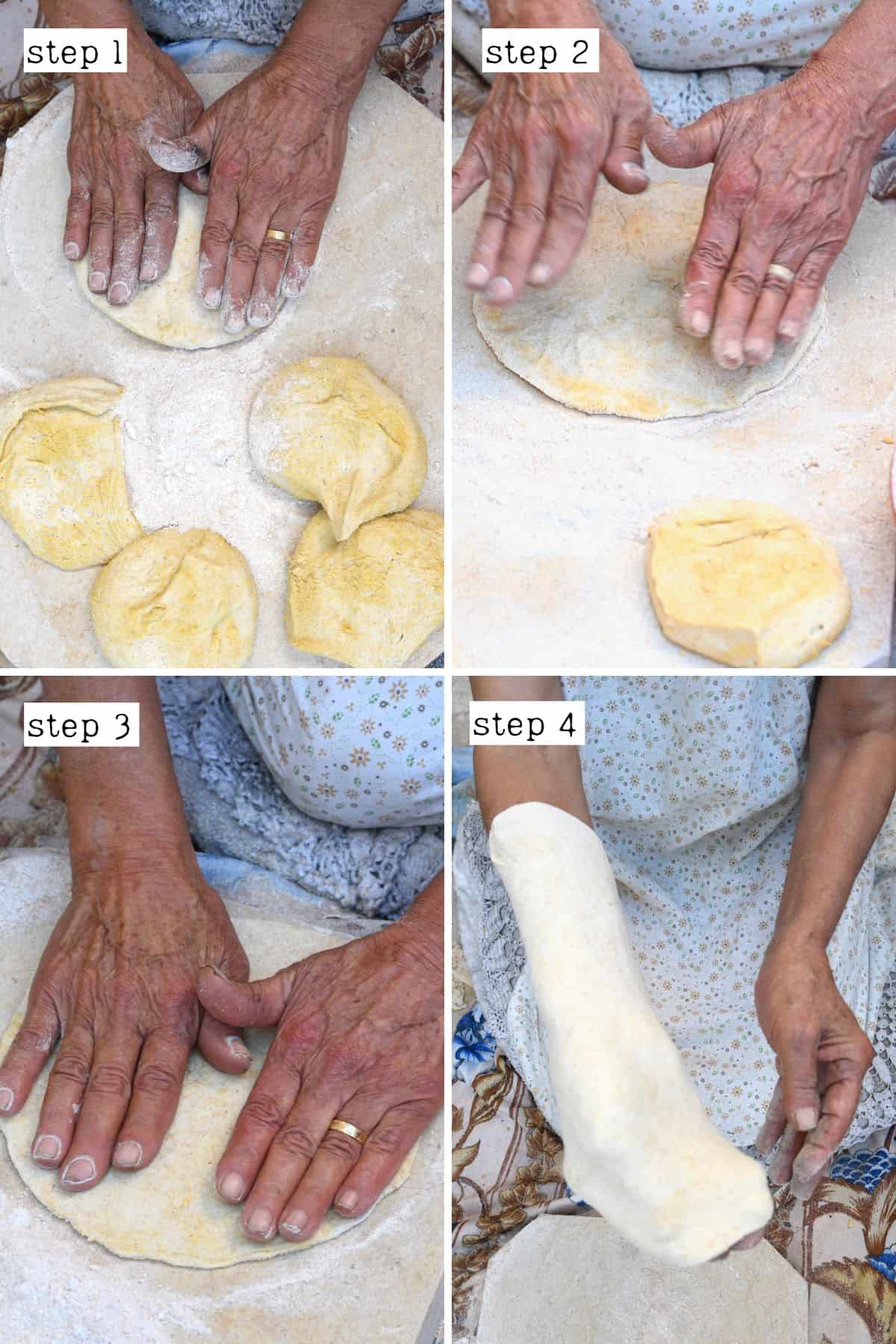
Then transfer the thin dough to your round pillow.
Meanwhile, preheat your pan. If you’re using a wok/Kadai pan, it will need to be inverted and over an open flame (gas stovetop or camping stove).
Once the dough is on the pillow, use your hands to gently pull it at the sides to stretch it over the pillow until it’s paper-thin and can be seen through.
Don’t worry if you get a couple of tears in them; this will still work fine. Just be gentler with the next one, and you’ll have the method sorted in no time.
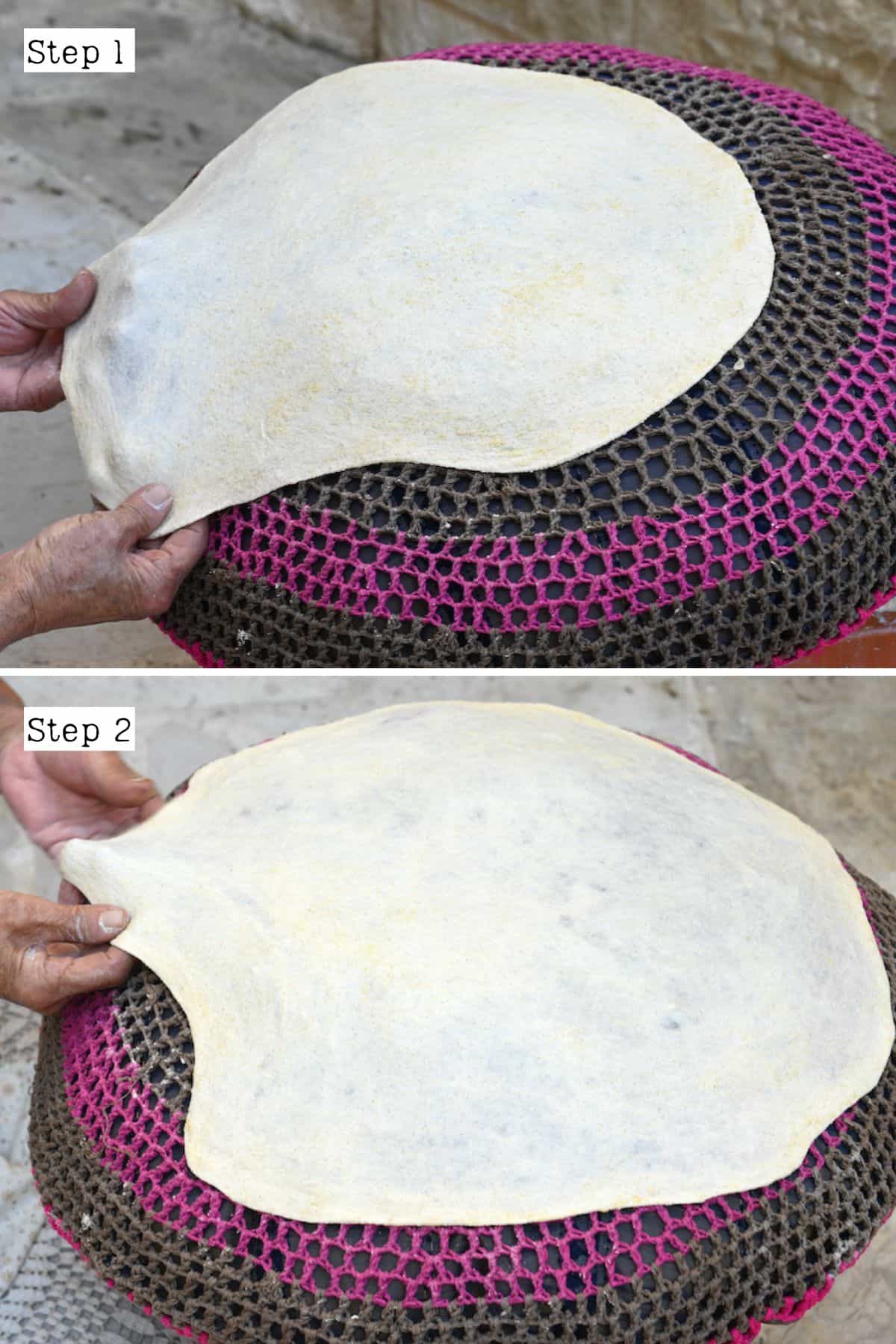
Step 4: Cook the Markouk Bread
To transfer the dough from the pillow to the wok/Kadai/crepe pan, pick up the pillow and flip it over onto the pan. Then leave it to cook untouched until you can see that the underside of the bread has browned and is beginning to get a little “crispy.” This will take between 1-2 minutes using an inverted work, but with a Saj, it can take as little as 15-20 seconds.
Meanwhile, as one flatbread cooks, you can shape and stretch the next dough piece.
Then, peel the markouk from the pan and set it aside over a clean kitchen towel (or surface). Wipe away any dough/mess left on the pan, and then repeat the above step with the remaining dough balls until all the bread is cooked.
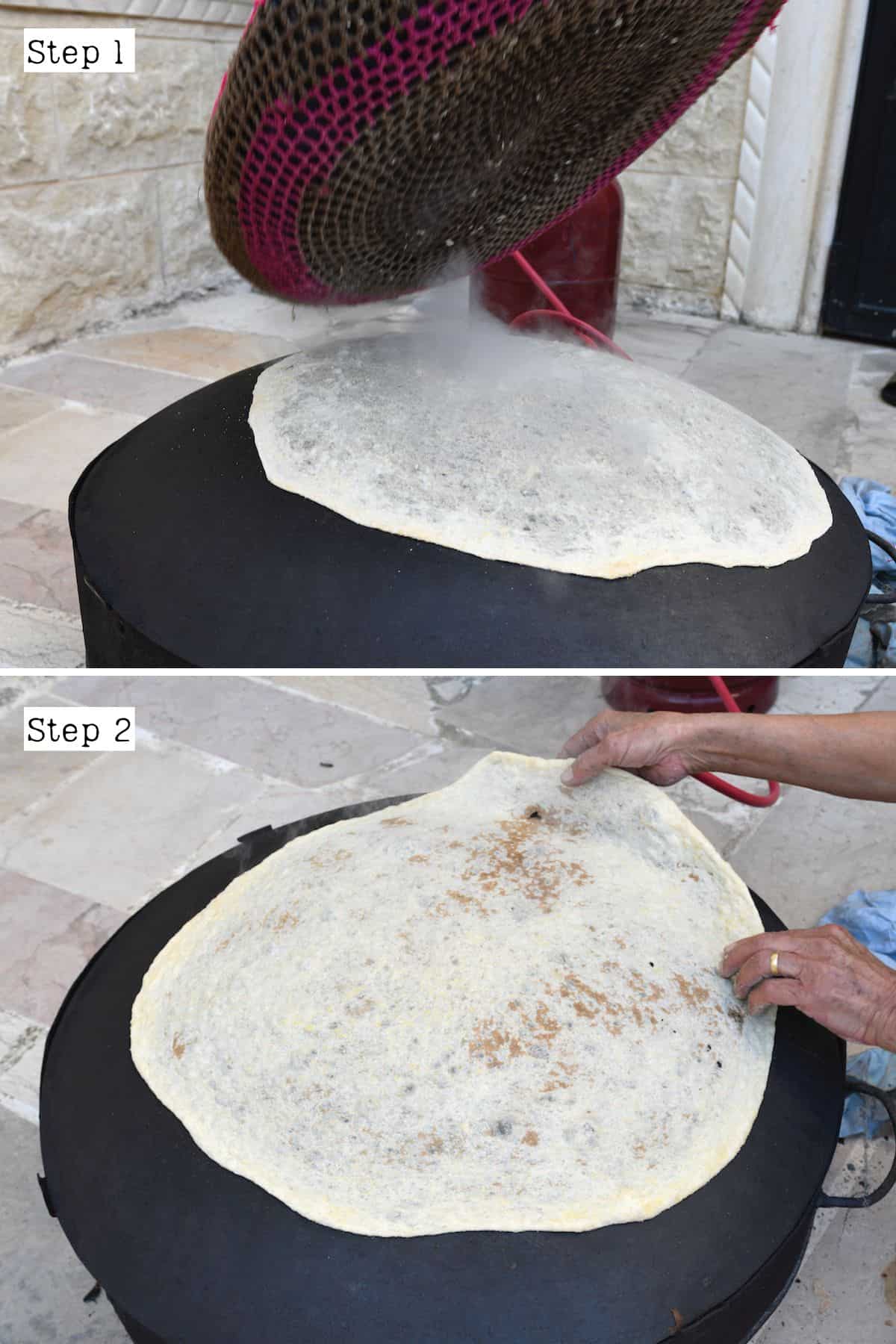
Step 5: Fold the Flatbread
Once it has cooled down, you can fold it (since this makes a large batch, so not all will be used immediately). There are two ways to fold it: either into triangles or rectangles/squares.
Triangle: Fold the flatbread in half, then half again, and once more.
Square: Fold both sides into the center (one folding over the other). Then fold the tops in towards the center to form a square.
You can then store it for later.
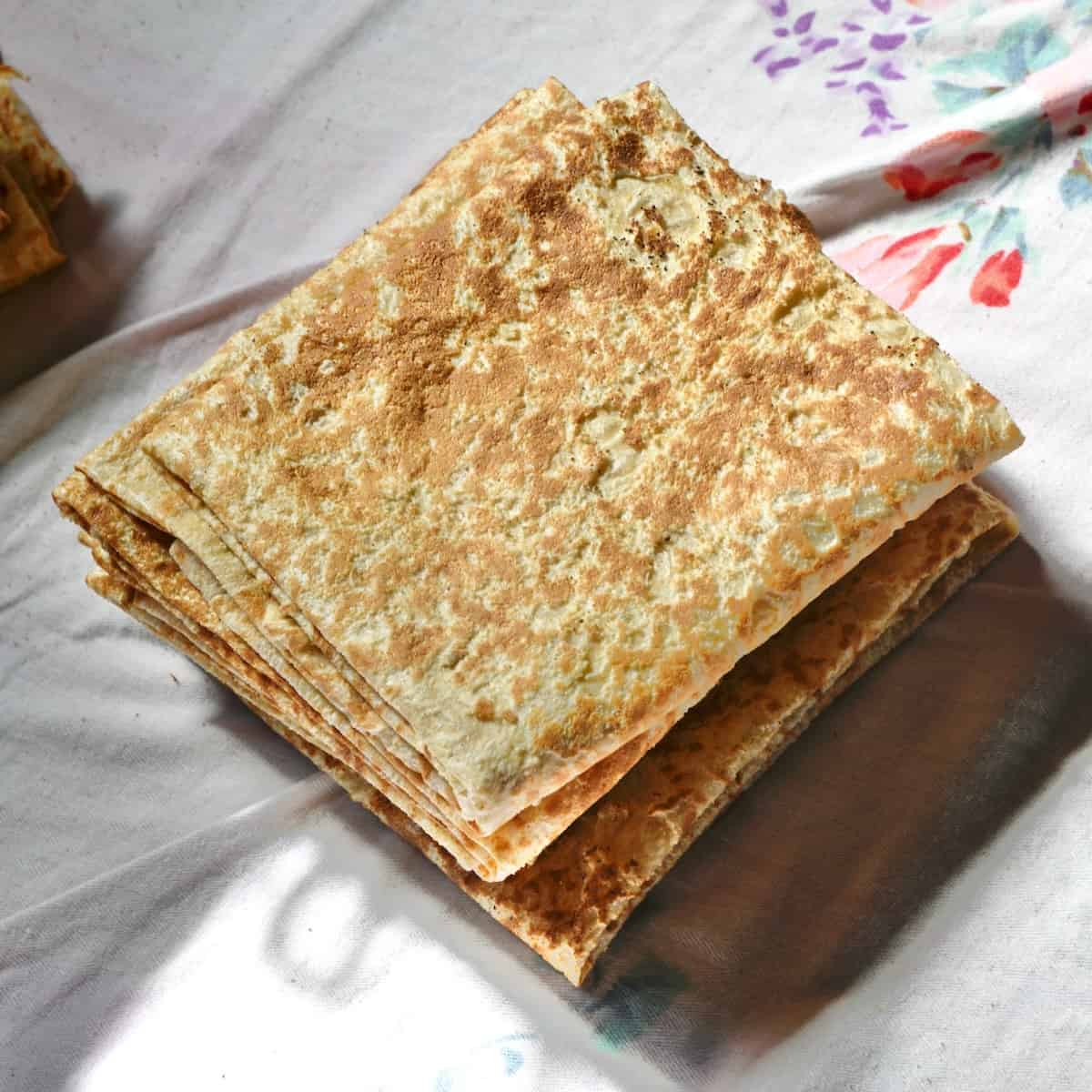
How to Store?
Make ahead: You may be able to stretch and fold the bread (with parchment paper in between the layers) in advance and then freeze it to cook for later – though I haven’t tried that yet – so I can’t give exact advice on the method.
Store: Transfer the fully cooled markouk bread to an airtight container/bag and store either in the cupboard for about a week or in the fridge for longer. Make sure to keep it well covered, or else the bread can dry out.
Freeze: Freeze in an airtight bag/container for up to 6 months (possibly longer, but I’ve never tried). Allow the bread to thaw in the fridge or at room temperature before using.
How to Serve?
There are several ways you can enjoy this Middle Eastern flatbread:
- As part of a breakfast spread alongside dishes like labneh, makdous, olives, tomatoes, preserves/jams, butter, cheese, etc.
- Serve with soups and stews for mopping up the sauce – or any dish with lots of sauce.
- Make a sandwich/wrap – for example, using the options listed in this tortilla hack method. I love to make a falafel sandwich with it and use it with chicken shawarma. You can also eat a saj sandwich with meat like kofta kebab.
- You can make Manakeesh topped with cheese or a blend of Za’atar and olive oil.
- Make into “borek” – this option requires a slight adaption to the cooking method as you’ll cover half the saj bread with your toppings (like cheese and spinach) and fold it over, then cook.
- Use to make flatbread pizza – top with a bit of tomato puree or marinara and cheese, then broil lightly until warm on top.
- Make a sweet wrap – for example, with homemade Nutella or banana and nut/seed butter.
One of my favorite combinations to use with this Lebanese bread is with zaatar, extra virgin olive oil, dandelion leaves, and salt – then rolled and folded in two. Simple and delicious!
You can also enjoy it as part of a mezze platter with dips and dishes like Lebanese tabbouleh salad, fatteh, baba ghanoush, muhammara, hummus, veggies, etc.
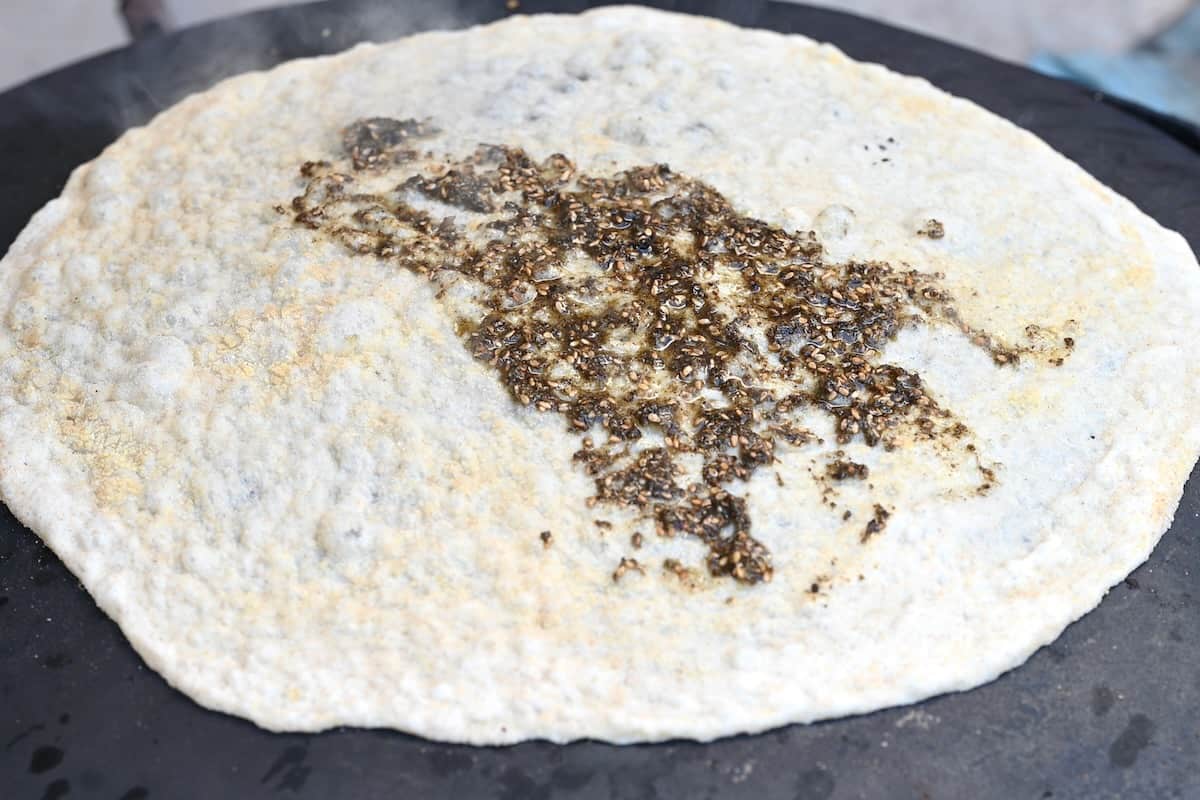
FAQs
Markouk bread is often compared to pita bread. However, in terms of its looks and uses, this paper-thin flatbread is more like a tortilla’s larger, flatter cousin (and is often eaten as a wrap).
Thanks to the combination of plain and whole wheat flour with salt, this saj bread is slightly nutty/earthy and savory.
Yes, you can – but I prefer the flavor of the markouk bread with it. However, feel free to experiment. But it might taste “lacking” without the whole wheat.
More Bread Recipes
- Fluffy Greek Pita
- 2-ingredient Sweet Potato Flatbread,
- Naan Bread
- No-knead Turkish Ramadan Pide Bread
If you try this Lebanese markouk saj bread recipe, let me know how it goes in the comments below. I’d appreciate a recipe card rating and would love to see your recipe recreations – tag me on Instagram @Alphafoodie!
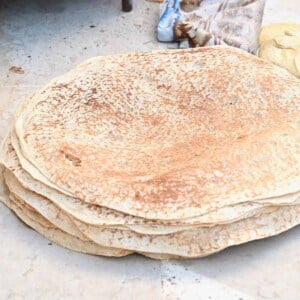
Lebanese Markouk Saj Bread
Equipment
- Saj or a wok, a kadai, or a crepe pan – recommended 24 inch/60 cm but smaller works too
- Round pillow covered with a kitchen towel if needed
Ingredients
- 4.35 lb white flour all-purpose flour
- 2.02 lb whole-wheat flour
- 0.95 oz sugar 2 Tbsp
- 1.95 oz salt 1/4 cup
- 0.07 oz yeast 1/2 tsp
- 10 cups water cold, + extra for when shaping the dough
- cornmeal or any flour, to dust the dough with
Instructions
Step 1: Prepare the dough
- Sift both types of flour into a large bowl. Then add the salt, sugar, and yeast and whisk well to combine.
- Add the cold water gradually, incorporating it into the dry ingredients until a soft dough has formed.
- Knead the dough for between 6-10 minutes until you have a smooth, elastic dough. You could also do this using a mixer for a few minutes.
Step 2: Divide and rest the dough
- Divide the dough into (around) 40 even pieces. For perfectly even pieces, weigh each one out. If you aren't too bothered about uniformity, you can do this by eye.If your wok/Kadai cooking tool is much smaller than 24 inches/60 cm then you can adjust the size of each dough ball accordingly (making them smaller).
- Dip your hands into water before shaping each dough piece into a ball- folding the edges underneath and pinching them together. Then roll/ sprinkle each ball with cornmeal and place them into a large flour-dusted bowl. Once all the dough balls are in the bowl, cover it with a clean, damp kitchen towel and leave it to rest for at least five hours – or overnight.
Step 3: Shape the flatbread
- Dust your working surface with some whole wheat flour. Then, working with one dough ball at a time, punch it down onto the surface to release extra air.
- Using your fingers, press the dough down on the edges (not the middle), rotating it often to stretch it into a large circular shape (similar to shaping pizza dough). Sprinkle the dough with flour often so it doesn't stick.
- Once it is as thin as you can get it with just your fingers dimpling the dough, it's time to use your whole hands to stretch it further. Place the dough in your left hand (you can do it from the palm or the top, whichever feels easiest for you) and then twist it quickly to transfer it to the palm of your right hand and back and forth, stretching the dough.
- Transfer the thin dough to your round pillow. Meanwhile, preheat your pan. If you’re using a wok/Kadai pan, it will need to be inverted and over an open flame (gas stovetop or camping stove).
- Once the dough is on the pillow, use your hands to gently pull it at the sides to stretch it over the pillow until it's paper-thin and can be seen through.Don't worry if you get a couple of tears in them; this will still work fine. Just be gentler with the next one, and you'll have the method sorted in no time.
Step 4: Cook the bread
- To transfer the dough from the pillow to the wok/Kadai/crepe pan, pick up the pillow and flip it over onto the pan. Leave it to cook untouched until you can see that the underside of the bread has browned and is beginning to get a little "crispy." This will take between 1-2 minutes using an inverted work, but with a Saj, it can take as little as 15-20 seconds.
- As one flatbread cooks, you can shape and stretch the next dough piece.
- Once cooked, peel the markouk from the pan and set it aside over a clean kitchen towel (or surface). Wipe away any dough/mess left on the pan, and then repeat the above step with the remaining dough balls until all the bread is cooked.
Step 5: Fold the flatbread
- Once the markouk has cooled down, you can fold it (since this makes a large batch, not all will be used immediately) – fold either into triangles or rectangles/squares.Triangle: Fold in half, then half again, and once more.Square: Fold both sides into the center (one folding over the other). Then fold the tops in towards the center to form a square.You can then store it for later.
Storage Instructions
- To Store: Transfer the fully cooled markouk bread to an airtight container/bag and store it either in the cupboard for about a week or in the fridge for longer. Make sure to keep it well covered, or else the bread can dry out.To Freeze: Freeze in an airtight bag/container for up to 6 months (possibly longer, but I've never tried). Allow the bread to thaw in the fridge or at room temperature before using.
Notes
- Try to roll it as thin as possible: The first few times you roll the dough, you might end up with thicker bread than expected (closer to a tortilla) – but the aim is for it to be almost paper-thin and to be able to see through it.
- Only cook on one side: Because the saj bread is so thin, there’s no need to flip it over. If you did, it would become too hard/crispy and wouldn’t fold/be pliable.
- The best pillow to use: When making traditional markouk bread, you’ll need a very large pillow (close to 24 inches/60cm diameter). However, when making the bread at home with a smaller wok/kadai, you could use a large naan pillow. Even better, try to find one with a handle. That way, it’s easy to flip the bread onto the pan.
- For a quick rise process: I like to leave the dough to rise overnight to break up the process. However, you could also speed up the process by using warm water instead of cold water in the dough and leaving the balls to rest for about 2 hours.
Nutrition
Nutrition information is automatically calculated, so should only be used as an approximation.

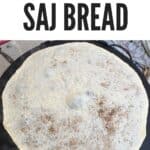
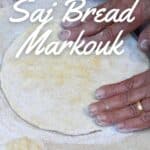

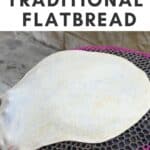
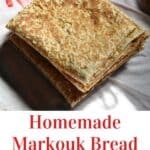
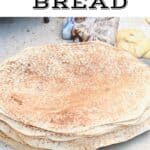
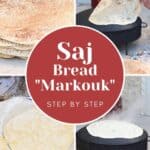










I’ve always wanted to give this a try. I usually stick to traditional saj bread recipes. I think i got it right after a couple of attempts, tried different recipes but the one that worked for me turned out amazing! But Lebanese markouk has been on my list for a while, and this recipe looks like something I could actually pull off. Thanks so much for sharing!
Thanks for sharing, Mike. I hope you give this recipe a try, too. I’m sure you’ll love it!
Hi! Do you use quick rising yeast or active dry yeast for the recipe?
Thank you so much, can’t wait to try out the recipe!
Hey Robin! For the recipe, you can use either quick rising yeast or active dry yeast. Both will work great! Let me know how it turns out!
This is very similar to the Sonoran handkerchief style tortillas, even the stretching..check out Herencia de las Viudas for more information..
Thanks so much for letting me know. I will check it out!
This might not be the right place to ask this but in 1993, while in the Marines I was assigned to assist a unit of troops from the United Arab Emirates. It was a great experience and I especially remember the food being very good. I was with them during Ramadan and remember that the Iftar meal was like a feast every evening. They always served this tortilla-like thing that had a sweet taste, that was basically used as a fork as well as a plate. If I ever asked what it was called, I don’t remember and I have thought about that since then. Do you have any clue what it might have been? There are no Arab or Middle Eastern stores or restaurants near me but any help you could give me would be appreciated.
Hey Chris! That sounds like an amazing experience, and I love that the food made such a lasting impression! Based on your description, it sounds like you might be referring to Regag (Rgaag) bread. It’s a thin, crispy Emirati flatbread that’s often used as an edible utensil and can have a slightly sweet taste, especially if served with honey, date syrup, or cheese.
Regag is similar to Markouk (Saj bread) but is usually thinner, crispier, and sometimes folded with fillings. If you’d like to recreate it, you can try making Markouk and rolling it extra thin, or search for Regag recipes for something closer to what you remember.
Hope this helps, and I love that you’re trying to reconnect with those flavors!
I think 1/4 cup of salt is a typo
Hi Diala,
1/4 cup is 4 Tbsp which is how much is needed for this recipe. It yield a lot of bread 🙂